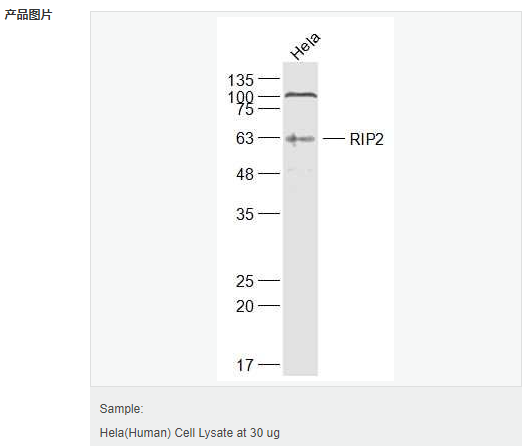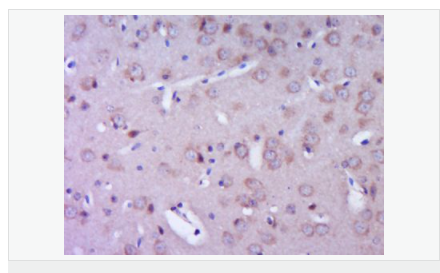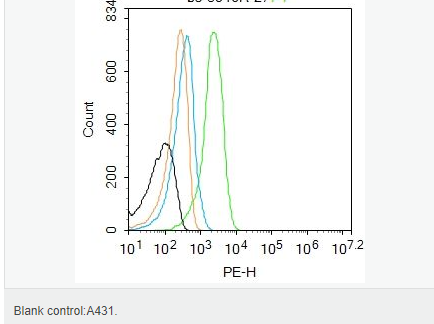

貨號
產(chǎn)品規(guī)格
售價
備注
BN40939R-100ul
100ul
¥2360.00
交叉反應(yīng):Human,Mouse(predicted:Rat,Dog,Pig,Cow,Rabbit,GuineaPig) 推薦應(yīng)用:WB,IHC-P,IHC-F,IF,Flow-Cyt,ELISA
BN40939R-200ul
200ul
¥3490.00
交叉反應(yīng):Human,Mouse(predicted:Rat,Dog,Pig,Cow,Rabbit,GuineaPig) 推薦應(yīng)用:WB,IHC-P,IHC-F,IF,Flow-Cyt,ELISA
產(chǎn)品描述
| 英文名稱 | RIP2 |
| 中文名稱 | 受體結(jié)合絲氨酸蘇氨酸激酶2抗體 |
| 別 名 | Receptor interacting protein 2; Receptor interacting serine threonine kinase 2; Receptor interacting serine/threonine protein kinase 2; RICK; RIP 2; RIP LIKE INTERACTING CLARP KINASE; RIPK 2; RIPK2; TNFRSF; CARD 3; CARD carrying kinase; CARD CONTAINING ICE ASSOCIATED KINASE; CARD containing IL 1 beta ICE kinase; CARD containing IL1 beta ICE kinase; CARD containing interleukin 1 beta converting enzyme (ICE) associated kinase; CARD containing interleukin 1 beta converting enzyme associated kinase; CARD3; CARDIAK; CCK; CLARP kinase; GIG 30; GIG30 ; Growth inhibiting gene 30; Receptor interacting protein (RIP) like interacting caspase like apoptosis regulatory protein (CLARP) kinase. |
| 研究領(lǐng)域 | 腫瘤 細胞生物 免疫學(xué) 細胞膜受體 |
| 抗體來源 | Rabbit |
| 克隆類型 | Polyclonal |
| 交叉反應(yīng) | Human, Mouse, (predicted: Rat, Dog, Pig, Cow, Rabbit, Guinea Pig, ) |
| 產(chǎn)品應(yīng)用 | WB=1:500-2000 ELISA=1:5000-10000 IHC-P=1:100-500 IHC-F=1:100-500 Flow-Cyt=2ug/Test IF=1:100-500 (石蠟切片需做抗原修復(fù)) not yet tested in other applications. optimal dilutions/concentrations should be determined by the end user. |
| 分 子 量 | 60kDa |
| 細胞定位 | 細胞漿 |
| 性 狀 | Liquid |
| 濃 度 | 1mg/ml |
| 免 疫 原 | KLH conjugated synthetic peptide derived from human RIP2:401-540/540 |
| 亞 型 | IgG |
| 純化方法 | affinity purified by Protein A |
| 儲 存 液 | 0.01M TBS(pH7.4) with 1% BSA, 0.03% Proclin300 and 50% Glycerol. |
| 保存條件 | Shipped at 4℃. Store at -20 °C for one year. Avoid repeated freeze/thaw cycles. |
| PubMed | PubMed |
| 產(chǎn)品介紹 | This gene encodes a member of the receptor-interacting protein (RIP) family of serine/threonine protein kinases. The encoded protein contains a C-terminal caspase activation and recruitment domain (CARD), and is a component of signaling complexes in both the innate and adaptive immune pathways. It is a potent activator of NF-kappaB and inducer of apoptosis in response to various stimuli. [provided by RefSeq, Jul 2008]. Function: Serine/threonine/tyrosine kinase that plays an essential role in modulation of innate and adaptive immune responses. Upon stimulation by bacterial peptidoglycans, NOD1 and NOD2 are activated, oligomerize and recruit RIPK2 through CARD-CARD domains. Contributes to the tyrosine phosphorylation of the guanine exchange factor ARHGEF2 through Src tyrosine kinase leading to NF-kappaB activation by NOD2. Once recruited, RIPK2 autophosphorylates and undergoes 'Lys-63'-linked polyubiquitination by E3 ubiquitin ligases XIAP, BIRC2 and BIRC3. The polyubiquitinated protein mediates the recruitment of MAP3K7/TAK1 to IKBKG/NEMO and induces 'Lys-63'-linked polyubiquitination of IKBKG/NEMO and subsequent activation of IKBKB/IKKB. In turn, NF-kappa-B is released from NF-kappa-B inhibitors and translocates into the nucleus where it activates the transcription of hundreds of genes involved in immune response, growth control, or protection against apoptosis. Plays also a role during engagement of the T-cell receptor (TCR) in promoting BCL10 phosphorylation and subsequent NF-kappa-B activation. Subunit: Found in a signaling complex consisting of at least ARHGEF2, NOD2 and RIPK2. Interacts with ARHGEF2; the interaction mediates tyrosine phosphorylation of RIPK2 by Src kinase CSK. Binds to CFLAR/CLARP and CASP1 via their CARD domains. Binds to BIRC3/c-IAP1 and BIRC2/c-IAP2, TRAF1, TRAF2, TRAF5 and TRAF6. May be a component of both the TNFRSF1A and TNRFSF5/CD40 receptor complex. Interacts with NOD1. Interacts (via CARD domain) with NOD2 (via CARD domain). Interacts with MAP3K4; this interaction sequesters RIPK2 from the NOD2 signaling pathway. Interacts with IKBKG/NEMO. The polyubiquitinated protein interacts with MAP3K7/TAK1. Interacts with XIAP/BIRC4. Interacts with NLRP10. Interacts with CARD9. Interacts with INAVA; the interaction takes place upon PRR stimulation (PubMed:28436939). Subcellular Location: Cytoplasm. Tissue Specificity: Detected in heart, brain, placenta, lung, peripheral blood leukocytes, spleen, kidney, testis, prostate, pancreas and lymph node. Post-translational modifications: Ubiquitinated on Lys-209; undergoes 'Lys-63'-linked polyubiquitination catalyzed by ITCH. Polyubiquitinated with 'Lys-48' and 'Lys-63'-linked chains by BIRC2/c-IAP1 and BIRC3/c-IAP2, leading to activation of NF-kappa-B. Also undergoes 'Met-1'-linked polyubiquitination; the head-to-tail linear polyubiquitination is mediated by the LUBAC complex in response to NOD2 stimulation. Linear polyubiquitination is restricted by FAM105B/otulin, probably to limit NOD2-dependent proinflammatory signaling activation of NF-kappa-B. Autophosphorylated. Autophosphorylation at Tyr-474 is necessary for effective NOD2 signaling. Phosphorylated. Phosphorylation at Tyr-381 by Src kinase CSK occurs in a ARHGEF2-dependent manner and is required for NOD2-dependent innate immune activation. Similarity: Belongs to the protein kinase superfamily. TKL Ser/Thr protein kinase family. SWISS: O43353 Gene ID: 8767 Database links: Entrez Gene: 8767 Human Entrez Gene: 192656 Mouse Omim: 603455 Human SwissProt: O43353 Human SwissProt: P58801 Mouse Unigene: 103755 Human Unigene: 112765 Mouse Unigene: 102179 Rat Important Note: This product as supplied is intended for research use only, not for use in human, therapeutic or diagnostic applications. |


